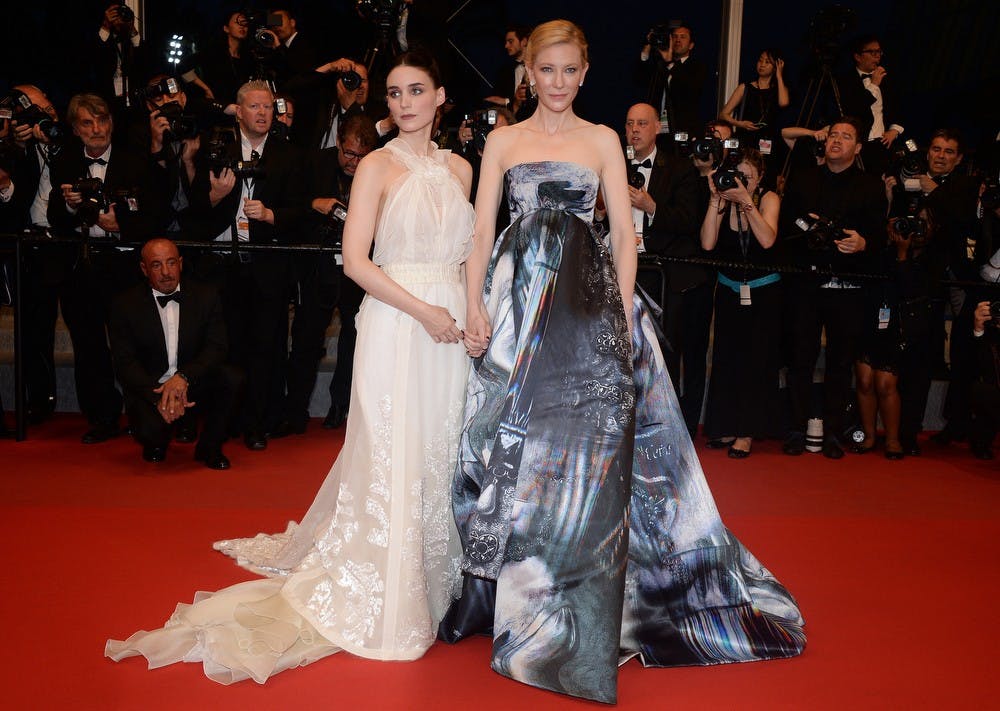Every scene of “Carol” is littered with beauty and has a special touch; even in the opening moments as the camera’s eye catches Carol’s (Cate Blanchett) lustrous gaze from inside a cozy restaurant. Carol is sitting with a younger, doe-eyed and innocent looking woman, Therese (Rooney Mara). The two are enjoying drinks moments before a gentleman, one of Therese’s old friends, approaches them to reminisce about that past.
To Carol, this is a cue for dismissal, and as she stands up, she rests her gloved hand on Therese’s shoulder tenderly, but with a firm, affectionate grip. It rests there for a few long seconds, and the two ladies lock eyes, sharing a loving but pained expression before Carol takes her leave. Seconds later, Therese’s old friend places his hand on her shoulder in the same way, but the affection, pain and history are not there. From the opening scene, director Todd Haynes shows Carol's aura of illusiveness and excellence, so much so that she commands the screen — from Therese’s eyes, no one can compare.
Therese and Carol first catch each other’s attention during the Christmas season when Carol is summoned to a department store to buy a toy for her young daughter, Rindy (Kennedy K. Heim). Therese is immediately fascinated by the woman and a misplaced glove possesses her to reach out to Carol.
As the holiday season progresses, the two begin to see more of each other and Therese learns of Carol’s troubled marriage that is winding down, and her custody battles with her husband, Harge (Kyle Chandler). As the two continue to meet, Therese's fascination is reciprocated and it surmounts to a dangerous love.
Like any love story, “Carol” can only be as strong as its two leads. Fortunately, Mara and Blanchett make one of the most romantic duos set on the silver screens. The titular Carol is a domineering and demanding character — one who broads without bragging. She symbolizes high class to the utmost degree and, much like real life Cate Blanchett, her natural elegance graces her every action. Yet, Carol is a tender lady who loves most things and doesn't seem to be a snob. Of the couple, Carol is the more complicated character, but she is open and her disposition allows for a better read.
When the two are together, their chemistry is electric and human. Never once does “Carol” come off as a stodgy drama, but always as something completely authentic and passionate. For gay marriage and queer rights contrarians, “Carol” would serve as an excellent counter-argument, because the love between Therese and Carol is unfaltering and real, especially in the film’s only sex scene, which is handled with an abundance of taste and elegance.
But, because this is a Todd Haynes passion project, the relationship is just the tip of the iceberg when it comes to “Carol’s” mastery. All technical elements are fully realized to match the setting of 1950s New York, which creates an immersive experience.
One of “Carol’s” most unique elements is the way Haynes, as a director, looks in on the world. The perspective doesn’t stay with Carol or Therese the entire film, but shifts between the two, which creates a unique look into their relationship. All of their faults are exposed throughout the film, which adds to the authenticity. Neither Therese or Carol are perfect people. In fact, they both seem a little selfish and confused, but seeing them through each other’s eyes makes the audience understand their love and fascination that much better.
Paired with the changing perspectives, screenwriter Phyllis Nagy and Todd Haynes bring many emotions to life in abstract ways. A reoccurring visual motif is the use of reflections and how Therese and Carol could be studying themselves to find their answers. Sometimes car windows or mirrors expose more about a character’s feelings than a close-up of their face, and Haynes and Nagy create dimensions and contradictions by building on these ideas.
Furthermore, Haynes frames many scenes in very intimate or selective ways. At the end of the first act, there is a scene of Carol’s best friend Abby (Sarah Paulson) speaking to Carol at a diner booth, but only Abby and an empty room is exposed. This method is used throughout the film to represent isolation. Haynes expands on these framing ideas throughout and creates an image within an image with so much depth that film students will be studying all the nuances of “Carol” for ages.
“Carol” is an instant classic and one of the cinema’s greatest love stories. Despite characters that resemble and signify a different time and a script more eloquent and loving than what today calls for, “Carol” feels timeless and essential. It had me under its spell and enchanted from the opening title card until the last scene, which is sure to be one of film history’s finest.
Related Links:
A movie most likely to surprise
'Focus' brings romance, drama to theaters
Reach the reporter at tanner.stechnij@asu.edu or follow @tannerstechnij on Twitter.
Like The State Press on Facebook and follow @statepress on Twitter.




